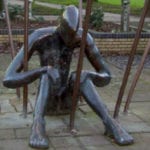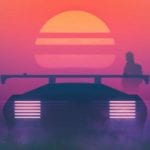 Miscellaneous
Miscellaneous  Miscellaneous
Miscellaneous  History
History 10 Unusual Things Famous Historical Figures Did for Love
 Religion
Religion 10 Epic Construction Projects That Took Centuries to Complete
 Miscellaneous
Miscellaneous 10 Iconic “Temporary” Structures That Still Stand Today
 Our World
Our World Ten Outlandish Ideas to Deal with Nuclear Waste
 Miscellaneous
Miscellaneous 10 Clever Loopholes That Forced Companies to Rewrite the Rules
 Animals
Animals 10 Secret Abilities of Well-Known Animals
 Movies and TV
Movies and TV 10 TV Revivals That Missed the Mark
 Space
Space 10 Crazy Ideas About Our Solar System
 Food
Food 10 Quirky, but Necessary, Food Safety Rules of the Past
 Miscellaneous
Miscellaneous 10 Tantalizing Stories About Money
 History
History 10 Unusual Things Famous Historical Figures Did for Love
 Religion
Religion 10 Epic Construction Projects That Took Centuries to Complete
Who's Behind Listverse?

Jamie Frater
Head Editor
Jamie founded Listverse due to an insatiable desire to share fascinating, obscure, and bizarre facts. He has been a guest speaker on numerous national radio and television stations and is a five time published author.
More About Us Miscellaneous
Miscellaneous 10 Iconic “Temporary” Structures That Still Stand Today
 Our World
Our World Ten Outlandish Ideas to Deal with Nuclear Waste
 Miscellaneous
Miscellaneous 10 Clever Loopholes That Forced Companies to Rewrite the Rules
 Animals
Animals 10 Secret Abilities of Well-Known Animals
 Movies and TV
Movies and TV 10 TV Revivals That Missed the Mark
 Space
Space 10 Crazy Ideas About Our Solar System
 Food
Food 10 Quirky, but Necessary, Food Safety Rules of the Past
Top 10 Terrifying Paintings By Great Artists
Often when we think of paintings in museums we imagine charming landscapes and stately portraits. However, art can be, and has often been, challenging in the subjects it portrays, or the way in which it presents ideas. Sometimes an artist creates a work so unsettling that it crosses the line from unnerving to scary. You might not want them hanging on your bedroom wall, but they are definitely worth examining. Here are ten of the most terrifying pictures by great artists.

William Blake is well-known today for his engravings and romantic poetry, but his reputation while alive was almost non-existent. Blake’s engravings and illustrations are classics of romantic style, and sprang from his imagination rather than close studies of nature. For our purposes it is Blake’s watercolor series which depict the great red dragon from the Book of Revelation, which merit his inclusion in this list. Here the great red dragon, an avatar of the Devil, is depicted in hideous glory standing over the seven-headed beast of the sea.

Francis Bacon was one of the most influential artists of the 20th century. His paintings are bold and bleak in the figurative style. His paintings sell for millions of pounds and even slash canvasses – Bacon destroyed works with which he was unhappy – sell for small fortunes. Over the course of Bacon’s life he returned to the portrait of Pope Innocent X by Velazquez, and made studies and interpretations of his own. Velazquez’s original shows Pope Innocent X looking pensively out of the canvas as if about to speak, Bacon has his Pope shrieking.
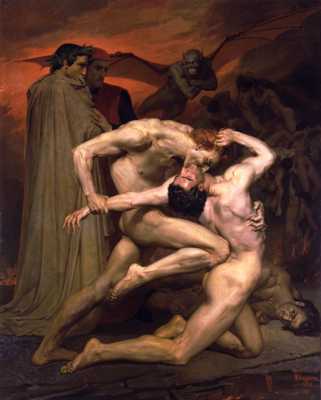
Dante’s inferno, with its imagery of tortuous damnation, has inspired artists ever since its publication. William-Adolphe Bouguereau is best known for his realistic images of classical scenes. However, here Bouguereau steps away from classical tranquility to the pits of hell, where the impersonators fight ceaselessly, stealing each others identities by biting. As a demon gloats, Dante and Virgil look on at the damned.
“In a frenzy, like pigs escaped from their sties,
Snapping wildly at everything in sight.
One of them fastened his teeth like a vise.”
Edvard Munch is Norway’s most famous painter. The Scream, his famous painting and expression of angst, has entered the public consciousness. Jean-Paul Marat was one of the leading political lights of the French revolution. Suffering from a skin disease, Marat was known to spend most of the day in a bathtub where he would work on his writings. It was there that Marat was assassinated by Charlotte Corday. The death of Marat has been painted several times, but Munch’s is a particularly brutal vision.
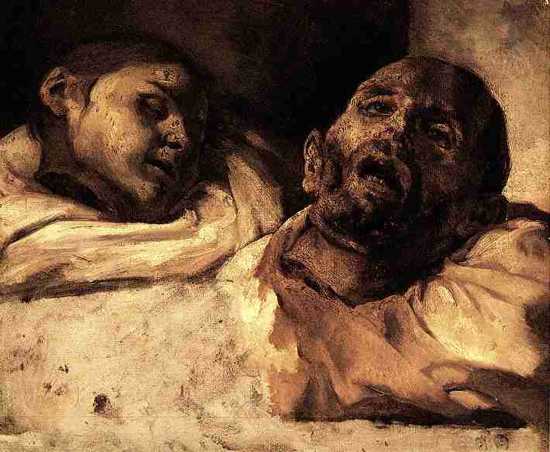
Gericault’s most famous work is the Raft of the Medusa, a vast romantic canvas which shows his artistic style. Gericault sought to break out of the classicism which was the standard painting style of his day. Romanticism was not afraid to tackle emotional subjects. Gericault worked on paintings such as this as prefatory pieces before he tackled his larger works. He found limbs and severed heads in the morgues and dissection labs of hospitals. The painting is troubling, but many great artists have studied the dead to better paint the living.

Grunewald painted religious imagery in the style of the middle ages, even though he lived during the renaissance. St Anthony the Great was said to have faced several trials and tests of his faith while worshiping in the desert. In one legend, St Anthony was killed by demons living in a cave, only to revive and destroy them later. This image from the Isenheim Triptych, three image altarpiece shows St Anthony succumbing to their attack. The bizarre collection of demons seen in the Isenheim altarpiece is reminiscent of the work of the more famous Hieronymus Bosch.

Emil Nolde was one of the early expressionist painters, though his fame has been eclipsed recently by other painters of expressionism such as Munch. Expressionism seeks to distort reality to reveal a subjective viewpoint. This painting was made as a study of masks in the Berlin museum, as well as a shrunken head. Throughout his life, Nolde showed a fascination with other cultures and this painting, with its interpretation of various masks, is in that same vein.

In Roman myth, based heavily on the Greek myth, the father of the Gods devours his own children to ensure none greater than himself ever comes into being. It is this act of child murder that Goya has painted. The painting was never meant for public consumption, as it was painted on the wall of his house alongside several other grim paintings known collectively as ‘The Black Paintings.’ Some see the painting as a comment on the aging process that must have been playing out in the aging artist’s mind. Of the Black Paintings which Goya completed the other most famous work is probably his Witches’ Sabbath.

The book of Judith in the Old Testament tells the story of a daring widow, Judith, and her saving of the Israelites. In the story, Israel is under attack by an army led by Holofernes. Judith sets out to meet him and uses her beauty to win her way into Holofernes’ heart. Once he trusts her, Judith then proceeds to get Holofernes drunk and, with her handmaid, decapitates the general to save Israel. This scene has been a popular one for artists, but Caravaggio’s version is particularly gruesome. The grim look of determination on the face of Judith’s handmaid counterbalances the unreadable expression on Judith herself, and the cry of terror on Holofernes’.
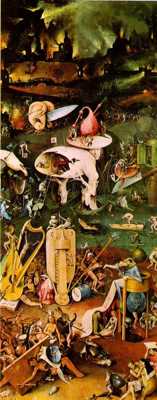
Hieronymus Bosch is linked in the popular imagination with his disquieting and fantastic religious paintings. The Garden of Earthly Delights is a triptych showing, on the three panels respectively, the Garden of Eden and the creation of mankind, the Garden of Earthly Delight, and in the last panel the punishments for the sins which occur in that earthly garden. It is that final panel, and the imaginative torments in it, which have become associated with Bosch. A glance at the panel is enough to give a feeling of the horrors divine punishment hold, but a close examination shows the true talent Bosch had for witty detail. The painting is packed with symbolism such as that seen in this portion.
All in all, Bosch’s work is some of the most horrific, yet beautiful work in the history of western art.



